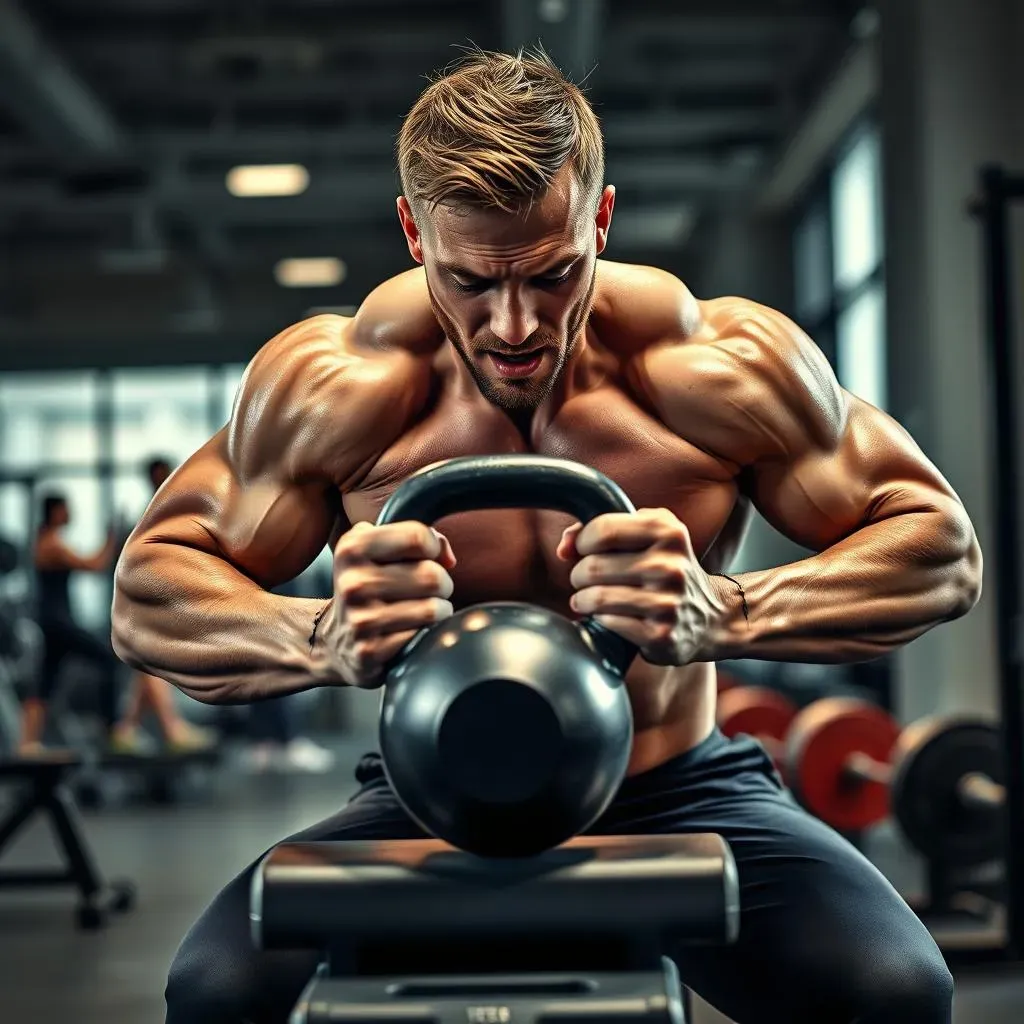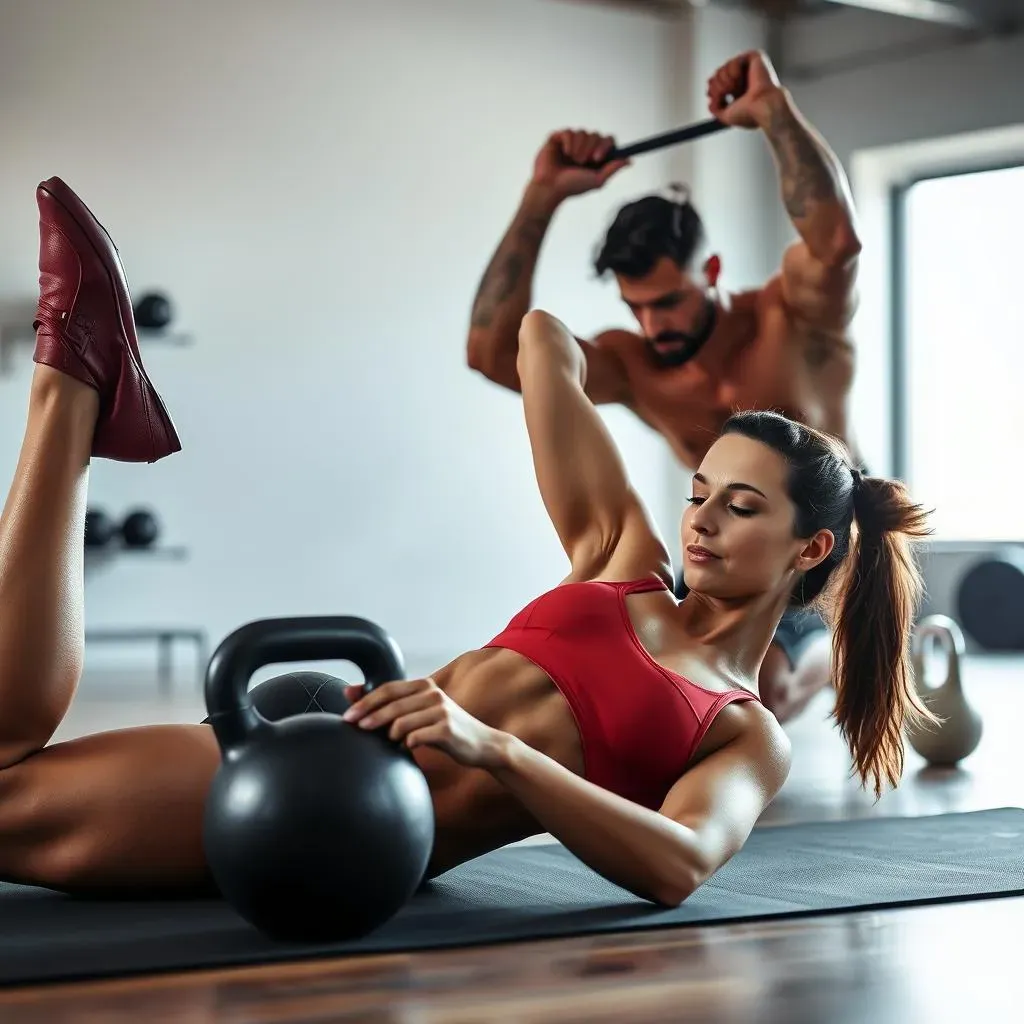Table of Contents
Ready to ditch the boring bench presses and sculpt a powerful upper body? A chest and shoulder kettlebell workout might be exactly what you need. Kettlebells aren't just for swings and squats; they're incredible tools for building functional strength and stability in your chest and shoulders. This article will guide you through the benefits of using kettlebells for your upper body, highlighting key exercises that target these muscle groups effectively. We'll break down how to craft a killer workout routine and offer tips on progressing safely to maximize your gains. Forget endless reps with dumbbells; let's explore how kettlebells can unlock a new level of strength and definition in your chest and shoulders. Get ready to swing, press, and build your way to a more powerful physique!
Why Choose a Kettlebell Chest and Shoulder Workout?

Why Choose a Kettlebell Chest and Shoulder Workout?
#1: Functional Strength and Real-World Power
Let's be honest, who doesn't want to feel strong and capable? Unlike isolation exercises that target individual muscles, kettlebell movements engage multiple muscle groups simultaneously. This means your chest and shoulder kettlebell workout isn't just building muscle; it's improving your overall functional strength. Think about it: pushing open a heavy door, lifting groceries, or even just hoisting yourself out of a chair – these everyday activities become easier when you train with kettlebells.
It's about translating gym gains into real-world power. Kettlebell exercises mimic natural movement patterns, strengthening the muscles you use every day. This leads to better posture, improved balance, and a reduced risk of injury. Plus, the dynamic nature of kettlebell training enhances your coordination and agility. It's not just about looking good; it's about feeling good and moving well.
#2: Stability, Core Engagement, and a Killer Burn
Here's the secret sauce: kettlebells demand stability. The offset weight of the kettlebell forces your core to work overtime to stabilize your body during each movement. This constant core engagement not only strengthens your abs and lower back but also improves your overall posture and spinal health. A strong core is the foundation for all movement, and kettlebells are masters at building that foundation.
And let's not forget the burn! A chest and shoulder kettlebell workout is no walk in the park. The combination of strength and cardio elements in kettlebell training will leave your muscles screaming (in a good way, of course). You'll torch calories, boost your metabolism, and build lean muscle mass all at the same time. It's an efficient and effective way to transform your physique and improve your overall fitness level.
Benefit | Description |
|---|---|
Functional Strength | Improves real-world power and everyday activities. |
Core Engagement | Strengthens core muscles, improves posture, and spinal health. |
Calorie Burn | Torches calories, boosts metabolism, and builds lean muscle. |
Essential Kettlebell Exercises for Chest and Shoulders

Essential Kettlebell Exercises for Chest and Shoulders
Kettlebell Floor Press: Your New Best Friend for Chest Development
let's get down to brass tacks. If you're serious about building your chest with kettlebells, the Kettlebell Floor Press is your go-to exercise. Why? Because it mimics the bench press but with a twist. Lying on the floor limits your range of motion, which forces you to focus on squeezing your chest muscles. Plus, it's easier on your shoulders than a traditional bench press, making it a great option if you have any shoulder sensitivities. Think of it as a bench press alternative that's actually good for your joints!
Here's how to nail it: Lie on your back with your knees bent and feet flat on the floor. Hold a kettlebell in one hand, with your elbow bent at a 90-degree angle. Press the kettlebell straight up towards the ceiling, focusing on contracting your chest muscles. Lower the kettlebell back down slowly and repeat. Aim for 3 sets of 10-12 reps on each side. Trust me, your chest will be feeling it!
Kettlebell Push Press: Shoulders and Core, Oh My!
Now, let's talk shoulders. The Kettlebell Push Press isn't just a shoulder exercise; it's a full-body movement that engages your core, legs, and, of course, your shoulders. This exercise is all about explosive power and coordination. You'll be using a little bit of leg drive to help you press the kettlebell overhead, which allows you to lift heavier weight and build more strength. It's a fantastic way to develop overhead pressing power and improve your overall athletic performance.
Here's the breakdown: Stand with your feet shoulder-width apart, holding a kettlebell in one hand in the rack position (kettlebell resting on your forearm). Dip down slightly by bending your knees, then explosively drive upwards, using your legs to help you press the kettlebell overhead. Lock out your arm at the top and then slowly lower the kettlebell back to the rack position. Repeat for 3 sets of 8-10 reps on each side. Remember, it's about controlled power, not just throwing the kettlebell up!
Exercise | Target Muscles | Benefits |
|---|---|---|
Kettlebell Floor Press | Chest, Triceps | Builds chest strength, easier on shoulders. |
Kettlebell Push Press | Shoulders, Core, Legs | Develops overhead power, improves coordination. |
Crafting Your Kettlebell Chest and Shoulder Workout Routine

Crafting Your Kettlebell Chest and Shoulder Workout Routine
#1: Designing Your Workout: Sets, Reps, and Rest
Alright, so you're ready to build your own chest and shoulder kettlebell workout. Awesome! But before you start swinging wildly, let's talk strategy. The key is to find the right balance of sets, reps, and rest to challenge your muscles without overdoing it. For most people, I recommend starting with 3 sets of 8-12 reps for each exercise. This rep range is ideal for building both strength and muscle mass. As for rest, aim for 60-90 seconds between sets. This will give your muscles enough time to recover so you can maintain good form throughout your workout. Remember, quality over quantity!
Don't be afraid to experiment and adjust these numbers based on your own fitness level and goals. If you're a beginner, you might want to start with fewer reps or longer rest periods. And if you're more advanced, you can increase the reps, decrease the rest, or even add more sets. The most important thing is to listen to your body and make sure you're not pushing yourself too hard, especially when you're first starting out. It's a marathon, not a sprint!
#2: Sample Workout and Progression
Let's put it all together with a sample chest and shoulder kettlebell workout routine. This routine is designed to hit all the major muscles in your chest and shoulders, and it's suitable for intermediate lifters. You can adjust the exercises, sets, and reps to fit your own needs and preferences.
Here's a sample workout:
- Kettlebell Floor Press: 3 sets of 8-12 reps
- Kettlebell Push Press: 3 sets of 8-10 reps per side
- Kettlebell Renegade Row: 3 sets of 8-10 reps per side
- Kettlebell Front Raise: 3 sets of 12-15 reps
To progress over time, you can gradually increase the weight of the kettlebell, the number of reps, or the number of sets. You can also try adding more challenging variations of the exercises. For example, you could progress from the Kettlebell Floor Press to a regular Kettlebell Bench Press. The possibilities are endless! Just remember to always prioritize good form and listen to your body.
Workout Component | Recommendation |
|---|---|
Sets | 3 sets per exercise |
Reps | 8-12 reps (adjust based on fitness level) |
Rest | 60-90 seconds between sets |
Progressing Your Chest and Shoulder Kettlebell Workout for Maximum Gains

Progressing Your Chest and Shoulder Kettlebell Workout for Maximum Gains
#1: Mastering the Fundamentals Before Adding Weight
so you've been crushing your chest and shoulder kettlebell workout for a few weeks now. You're feeling stronger, your muscles are more defined, and you're ready to take things to the next level. But hold on a second! Before you start grabbing the heaviest kettlebell in the gym, let's talk about the importance of mastering the fundamentals. You need to make sure you have perfect form on every exercise before you start adding weight. This means your movements should be smooth, controlled, and pain-free. If you're struggling with your form, it's better to stick with a lighter weight until you've nailed it. Trust me, it's worth the extra time and effort.
Why is proper form so important? Because it's the key to preventing injuries and maximizing your results. When you use good form, you're engaging the right muscles and protecting your joints. But when you use bad form, you're putting unnecessary stress on your body, which can lead to pain, inflammation, and even serious injuries. So, take the time to learn the proper technique for each exercise, and don't be afraid to ask a qualified trainer for help. Your body will thank you for it!
#2: Gradual Overload: The Key to Long-Term Gains
Once you've mastered the fundamentals, it's time to start thinking about gradual overload. This is the principle of progressively increasing the demands on your muscles over time. There are several ways to do this. You can increase the weight of the kettlebell, the number of reps, the number of sets, or the difficulty of the exercises. The key is to make small, incremental changes that challenge your muscles without overwhelming them. For example, instead of jumping from a 16kg kettlebell to a 24kg kettlebell, try using an 18kg or 20kg kettlebell first. This will give your muscles time to adapt and grow stronger.
Another way to implement gradual overload is to vary your exercises. Instead of doing the same routine week after week, try adding new exercises or variations that target your chest and shoulders in different ways. For example, you could switch from the Kettlebell Floor Press to a Kettlebell Bench Press, or you could add incline or decline variations to your push-ups. This will help to prevent plateaus and keep your muscles guessing. Remember, the goal is to constantly challenge your body in new and different ways to stimulate growth and strength gains. Don't let your muscles get too comfortable!
Progression Method | Description | Example |
|---|---|---|
Increase Weight | Gradually increase the weight of the kettlebell. | Move from a 16kg to an 18kg kettlebell. |
Increase Reps | Increase the number of repetitions per set. | Go from 8 reps to 10 reps per set. |
Increase Sets | Increase the number of sets per exercise. | Add an extra set to each exercise. |
Exercise Variation | Change the exercise to target muscles differently. | Switch from Floor Press to Bench Press. |
Conclusion: Kettlebells for a Stronger You
Incorporating a chest and shoulder kettlebell workout into your routine is a game-changer for building functional strength, improving stability, and sculpting a defined upper body. From mastering essential exercises to crafting a progressive workout plan, the kettlebell offers a versatile and effective approach to training. So, grab a kettlebell, embrace the challenge, and unlock the powerful potential of your chest and shoulders. The results will speak for themselves.